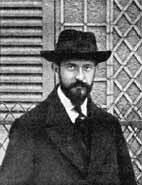Jan Kazimierz Danysz

Jean Danysz (11 March 1884 – 4 November 1914) born Jan Kazimierz Danysz, was a French physicist of Polish extraction. He was an assistant of Maria Skłodowska-Curie and notable in the development of beta spectrometry.
Danysz made considerable advances on the magnetic deflection techniques of Baeyer, Hahn and Meitner, placing the source (he used radium) in a capillary tube under a slit, with a photographic plate in the same horizontal plane. By this means the known number of lines (later understood to be conversion lines) superimposed on the beta energy spectrum of RaB + RaC went from 9 to 27 (later work by Robinson and Rutherford found 64; 16 from RaB and 48 from RaC).[1] He finished his doctoral thesis in 1913, and by 1914 he was considered by Rutherford as a leading researcher into beta decay,[2] but he did no further work. He enlisted in the French army in 1914 and was killed in action near Cormicy.[3]
Publications
J. Danysz, Le Radium 9, 1 (1912); 10, 4 (1913)
Danysz, J. Recherches expérimentales sur les β rayons de la famille du radium Ann. Chim. Phys. 30 (1913) 241–320
Family
- He was the son of biologist Jean Danysz (1860-1928).[4]
- He was the father of physicist Marian Danysz (1909–1983).
References
- ^ RaA was a placeholder for an isotope later identified as 218Po; RaB for an isotope later identified as 214Pb - see Radium series
- ^ Jensen, Carsten (editor) Controversy and Consensus: Nuclear Beta Decay 1911-1934 Chapter 2.4 Deflection experiments. p. 37
- ^ Extract from Livre d'or de l'École de physique et de chimie
- ^ Bulletin littéraire et scientifique (Association des anciens élèves de l'Ecole polonaise) - 1914/12/15 (Année 39, N°316)
